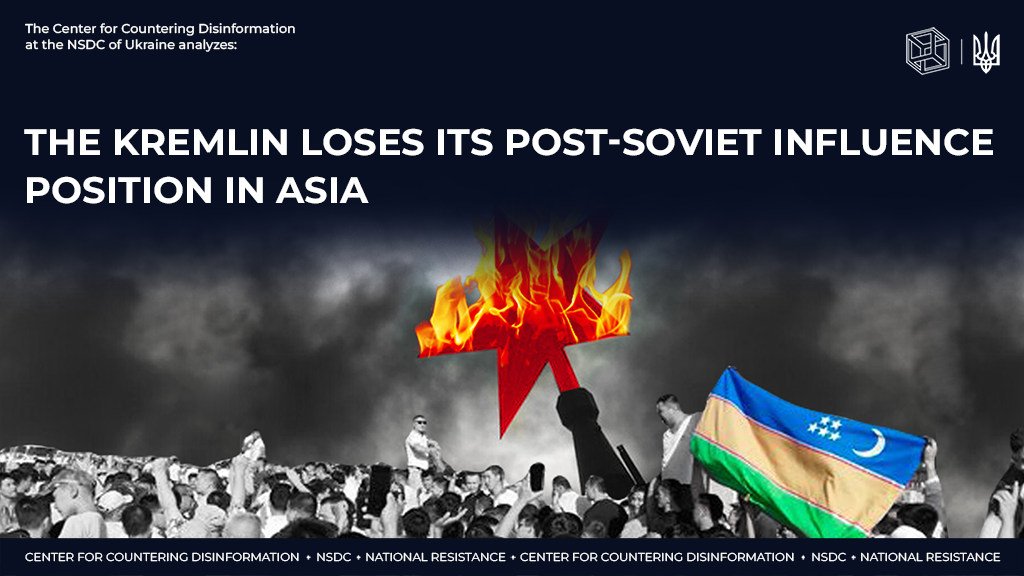Control over the political elites of the post-Soviet countries of Central Asia remains extremely important for the kremlin.
After all, the events in Dushanbe (capital of Tajikistan) and Ashgabat (capital of Turkmenistan), make explicit that putin is gradually losing control over the Asian countries.
That is why the only worked-out way remains, namely to “ignite” Middle Asia from the inside with “rolled-out” scenarios in Moldova, Georgia and Ukraine.
At this time, the goal for hybrid aggression was Uzbekistan, the most densely populated Republic of the region. However, then the question arises: why Uzbekistan?
Firstly, Tashkent has recently been demonstrating a way out of russia’s influence and its economic policy is increasingly oriented toward Kazakhstan, China and the USA.
Secondly, Uzbekistan twice joined and withdrew from the Collective Security Treaty Organization (last time in 2012). Since then, Tashkent has remained steadfast in its intention to keep away from this pro-russian military bloc.
Thirdly, the geopolitical state of the country makes its disorganization indicative for such neighboring countries as Kazakhstan, Kyrgyzstan, Tajikistan and Turkmenistan.
That is the reason why the development of events in the mono-ethnic Karakalpakstan and the algorithm of subverting the country are very similar to the combination of “Crimean” and Donbas” scenarios in Ukraine as well as January events in Kazakhstan.
The previous conditions for the kremlin’s subversive activities were similar: acute conflict of political elites, separatist sentiments, attempts to seize state institutions, use of weapons and the actions of instigators.
Karakalpakstan, where major protests have emerged, is the largest region of the country (40% of the territory of Uzbekistan and 1,5 million people). According to the Constitution of 1993 it is recognized as a “sovereign Republic” (i.e. has the status of autonomy, even wider than the Autonomous Republic of Crimea).
Seventeenth Chapter of the Uzbekistan Constitution guarantees the Karakalpakstan residents the right to secession on the basis of the national plebiscite in the region.
Of course, Uzbekistan’s independence is not a preferred option for the kremlin.
Therefore, the temptation to “undermine the foundations” of Uzbekistan through an illegitimate “referendum” and the creation of another quasi-state similar to South Ossetia, Transdniestrian Moldavian Republic and CDDLO (Certain Districts of Donetsk and Luhansk oblasts) was appealing for putin.
So, new amendments to the Constitution of Uzbekistan became a formal reason for mass protests of Karakalpakstan, among which is the sovereignty abolition of the autonomous Republic.
The information wave, that appeared in local Telegram channels, clearly inspired by the Russian special services, unfolded in instant appeals to protest not only against the amendments, but also against the Uzbek authorities in general.
At first, peaceful protests in Nukus, the capital of the region, with the help of provocateurs in the crowd from the internal russian special services for subversion quickly grew into an attempt to storm the buildings of the authorities and clashes with law enforcement units, that fired not only rubber bullets and smoke bombs, but also fire-arms into the demonstrators.
Only a visit of President Shavkat Mirziyoev to Nukus, namely his statement to cancel the promised amendments stopped the bloodshed. At present, the government has declared a state of emergency, blocked social networks and mobile connection.
Meanwhile, the russian propaganda is predictably highlighting the protests in Uzbekistan as an attempt of the state coup. It is trying to shift all responsibility to the President of Kazakhstan Kassym-Jomart Tokayev, accusing him in attempt to incite two countries and a desire to take over the leader role in the Central Asian region.
In fact, it is a revenge for Kazakhstan’s position on “special operation” in Ukraine, the lack of recognition for the quasi-state structure of Donbas and the gap from the kremlin’s influence.
A failed attempt to make Uzbekistan “Asian Ukraine” has significantly struck on the image of the Kremlin authorities. The defeat of the “Uzbek” and earlier “Kazakh scenarios” shows that russia is losing its influence on the former colonies in the Central Asian region.
Thus, the conflict in Uzbekistan is another dangerous precedent near the russian borders, which creates the preconditions for the loosening of statehood in russia itself.
#infoterror










